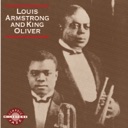New Orleans–Style Jazz
Louis Daniel Armstrong
Library of Congress Prints and Photographs DivisionKey Attributes of New Orleans–Style Jazz
Select to filter timelineThemes
- Migration
- Dance
- Love/Relationships
- Daily Life
- War
Musical Features
- Improvisation
- Ensemble
- Syncopation
- Instrumentals
- Call and Response
- Vocal Sounds
Instruments
- Trumpet
- Trombone
- Drums
- Horn
- Strings
- Woodwinds
“Usually they would hire a band. Most of the time it was string bands...[they] usually had a mandolin, guitar, bass, and a violin in there. Sometimes you’d see an accordion or a banjo...To me, those are your first jazz bands.”Joe DarensbourgClarinetist (born 1906)
Definition
New Orleans’s unique history produced an ethnically, racially and culturally diverse population that encompassed African Americans (free and enslaved), people of French, Spanish and Creole heritage, in addition to immigrants from Cuba and the Caribbean. The cross-influences of these African-derived cultures mixed with those of Creoles (mixed French and African heritage) set the stage for the development of a distinctive New Orleans jazz style.
New Orleans’s jazz is a 20th-century type of collectively improvised ensemble music that draws from several sources: ragtime, blues, marches (syncopated brass bands), African American religious music (gospel hymns), European classical music, popular song, minstrelsy, and musicals. New Orleans jazz is unique, having evolved from the African and Caribbean call-and-response chants and drumming practiced by African Americans in the city during the post–Civil War era, and from the dance music played by brass bands that became popular in that city. The improvisational element of jazz is attributed to their creativity and to the need for New Orleans musicians, many of whom could not read music, to extend songs for dancers and in parades. Drawing from blues elements and quickening the tempo of the music, the seven-member ensembles created the basics of what would become jazz. New Orleans jazz is primarily dance music, played in 2/4 or 4/4 time, as illustrated in Freddie Keppard’s Jazz Cardinals “Stock Yards Strut” (1926). It is often called Dixieland, although some historians argue that the two terms are not interchangeable, with Dixieland being a subset of New Orleans jazz.
Context and History
At the turn of the 20th century, many of New Orleans’ early jazz musicians began their professional careers performing in ragtime-style syncopated brass bands that played for funeral ceremonies. Syncopated dance bands influenced these “funeral bands.” Cornetist Buddy Bolden (1877–1931) is credited as establishing the first ensemble in jazz history, improvising on the ragtime style and incorporating blues and spirituals; Bolden is also credited as the first to use brass instruments to play blues. Although African American musicians in other Southern cities developed an improvised ensemble-oriented jazz style drawing from similar sources, New Orleans musicians shaped a distinctive improvisatory style that reflected the traditions of its diverse population.
Jazz was national, and not simply regional, as evident in the formation of the Original Creole Jazz Band in Los Angeles around 1910 (admittedly made up of New Orleans musicians such as Freddy Keppard). The word “jazz” first appeared in print in the context of a California baseball game about this time. “Jelly Roll” Morton visited northern and southern California around World War I. Native Oaklander Sid Le Protti’s So Different Jazz Band played in downtown San Francisco during the war years, while King Oliver’s band performed in the Bay Area and Los Angeles in 1921 before he became a hit in Chicago. One of the first jazz records, with an orchestra led by the Louisianan Edward “Kid” Ory, was made in Los Angeles in 1921, so the Golden State’s history is closely connected with early jazz.
Some New Orleans musicians performed in various resorts in Storyville, the city’s “red light district.” This district was named after councilman Sidney Story, who drafted district boundaries for authorities to regulate and monitor illicit activities. Although New Orleans jazz did not originate in Storyville, the music flourished in this district. Many visitors to the city heard jazz performances for the first time in Storyville as well as in all-Black streets in uptown New Orleans. Even before the closing of this district in 1917, musicians migrated to Northern, Midwestern, and West Coast cities.
Musical Features/Performance Style
The instrumentation of New Orleans jazz derives from funeral, brass, and dance bands; cornet, clarinet, trombone, tuba, banjo, and drums became the core instrumentation. Other distinctive features are the improvisatory style with a blues feeling and a unique ragged approach to the rhythmic interpretation of songs, as heard in the recordings of Joe “King” Oliver’s Creole Jazz Band (“Dippermouth Blues”), Louis Armstrong (“Strutting with Some Barbeque” and “Mack the Knife”), and Freddie Keppard (“Stock Yard Strut”).
Louis Armstrong was influential in shaping a vocal aesthetic in early jazz. Expanding the horizons of individual creativity, he shifted the emphasis from a strictly collective improvisational format to a structure that allowed for both a complete instrumental solo and a newly emerging vocal style. Armstrong used his voice as if it were an instrument, bending and sliding around the pitch. This wordless vocalizing style became the foundation for what later became known as “scat singing” and broadened the horizon for vocal innovations.
Lyrics
New Orleans–style jazz is primarily a collective improvisational instrumental art form without a vocal tradition. When vocals were added, the repertoire consisted of blues and popular standards of the day. The text for many of these songs draws upon life experiences, hardships, and romance as heard in “Jelly Roll” Morton’s “Hesitation Blues.”
Bibliography
- Armstrong, Louis. Louis Armstrong In His Own Words: Selected Writings. New York: Oxford University Press, 1999.
- Armstrong, Louis. Satchmo: My Life in New Orleans. New York: Da Capo Paperback, 1986 [1954].
- Gioia, Ted. The History of Jazz. New York: Oxford University Press, 1997.
- Marquis, Donald M. In Search of Buddy Bolden: First Man of Jazz. Re. Ed. Baton Rouge: Louisiana State University Press, 2005.
- Stoddard, Tom. Pops Foster: The Autobiography of a New Orleans Jazzman as Told to Tom Stoddard. Berkeley: University of California Press, 1971.













